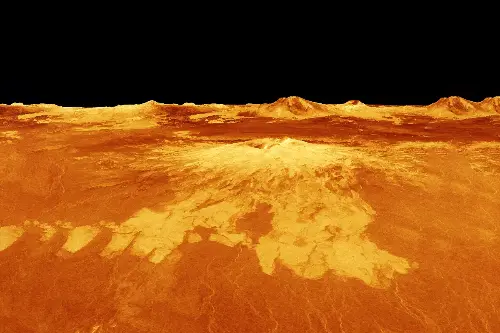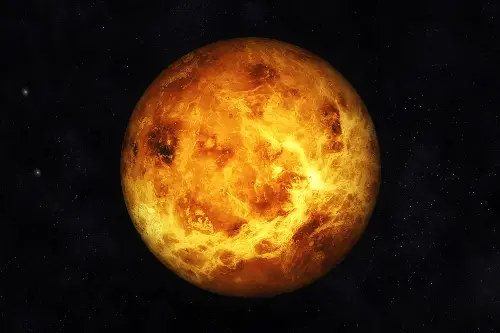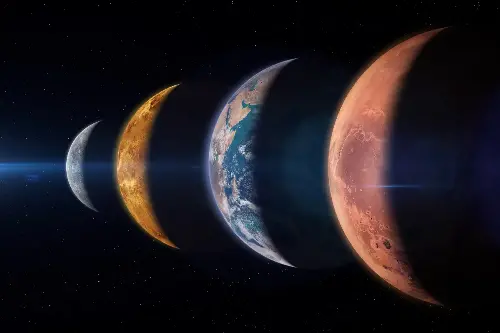Our neighbouring planet Venus is often thought of as Earth's twin due to its similar size and proximity. However, appearances can be deceiving. Venus's thick, toxic atmosphere and scorching surface temperatures paint an image of a world that is vastly different from our blue planet, evoking a sense of awe and wonder about its extreme conditions.
Closer to the sun than Earth, Venus is the second planet from the star and is named after the Roman goddess of love and beauty. But the planet's environment is anything but lovely. The surface is dominated by intense heat, strong enough to melt lead, which is a direct result of a runaway greenhouse effect. This effect is caused by a thick atmosphere comprised mainly of carbon dioxide, with clouds of sulphuric acid, making it an inhospitable place for life as we know it.
Exploring Venus's Fiery Surface

The surface temperature on Venus averages a sweltering 464 degrees Celsius (867 degrees Fahrenheit), which is more than hot enough to cook a pizza in just seven seconds! These intense conditions are present day and night due to the slow rotation of the planet. It takes Venus 243 Earth days to complete one rotation on its axis, which is longer than its 225-Earth-day orbit around the Sun.
The landscape of Venus is a mosaic of volcanoes, mountains, and vast plains. Around 80% of the planet's surface is covered by volcanic plains, featuring extensive lava flows and pancake-like volcanoes called 'shield volcanoes.' Radar imaging has provided evidence of relatively fresh lava flows, suggesting that the planet is not geologically dead but rather that it houses a fiery, churning interior.
The Mystery of Venusian Storms
Amid the pressure cooker of Venus's atmosphere, the weather system reveals ferocious winds and monstrous storms. The upper atmospheric winds on Venus can reach speeds of up to 360 kilometres per hour, which is faster than the speediest tornado on Earth. These winds move in a phenomenon known as 'super-rotation,' where the atmosphere spins significantly faster than the planet's slow rotation.
The thick clouds surrounding Venus reflect over 70% of the sunlight that reaches the planet. This high albedo (reflectivity) prevents us from seeing the planet's surface with traditional optical telescopes. Instead, scientists penetrate this veil using advanced radar imaging to study the topography and meteorological conditions.
Venus's Enigmatic Glows and Dark Streaks

Venus is home to some of the most enigmatic phenomena in the solar system. For instance, researchers have been intrigued by the discovery of a pale-yellow glow emanating from the upper clouds on the night side of Venus. This mysterious 'ashen light,' first reported by astronomers centuries ago, is still not fully understood, with hypotheses ranging from electrical activity in the atmosphere to the reflection of sunlight from interplanetary dust.
Another mystery is the presence of dark streaks decorating the clouds that are believed to be caused by microorganisms or complex chemical processes related to the sulphur in the atmosphere. These absorbing features are ever-changing, giving Venus a dynamic and puzzling meteorological life.
Venus's Quest for Understanding
All these characteristics make Venus an intriguing subject of study. Researchers are keen to understand not just the present climate and geology but also its past. There's evidence to suggest that Venus may have had liquid water and a more Earth-like climate billions of years ago. What happened to transform it into the hothouse we observe today is a subject of intense research and speculation.
Future missions to Venus, like NASA's VERITAS (Venus Emissivity, Radio Science, InSAR, Topography, and Spectroscopy) and ESA's EnVision, aim to map the planet's surface in greater detail and analyse its geological history. These missions may provide precious insights into the planet's evolution and help identify whether Venus was ever capable of supporting life.
Venus as a Lesson for Earth’s Future

Studying Venus offers more than just an opportunity to quench our celestial curiosity. It serves as a stark reminder of the critical balance of planetary factors that sustain life. Venus's intense greenhouse effect provides a cautionary example of climate change, suggesting what might happen if Earth's atmospheric conditions were pushed to their extreme.
Understanding Venus helps us appreciate the dizzying complexity and fragility of our own planet's climate system. It prompts us to consider the delicate harmonies that allow life on Earth to flourish and what actions are needed to preserve it. The study of Venus is not just about unravelling the secrets of a distant world; it's about safeguarding the future of our own.
